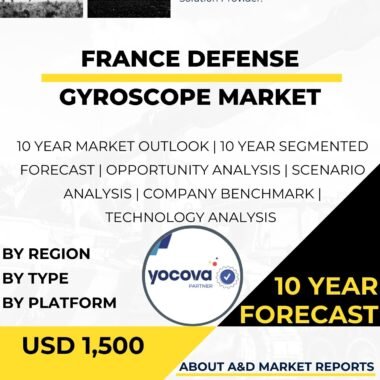Description
United Kingdom Defense Gyroscope Market Overview
The United Kingdom Defense Gyroscope is a critical sector that supports the country’s military operations. Gyroscope technologies improve navigation, stabilization, and control across defense platforms. Gyroscopes measure and maintain orientation and angular velocity. These functions are essential for aircraft, ships, submarines, missiles, unmanned systems, and ground vehicles. The United Kingdom continues to invest in advanced gyroscope systems to strengthen its defense capabilities.
Applications in the United Kingdom Defense Gyroscope Market
Gyroscopes in Military Aviation
Gyroscopes are core components in modern aircraft.
They support:
-
Aircraft stability
-
Attitude control
-
Maneuverability
-
Accurate navigation
In United Kingdom military aviation, gyroscopes work within autopilot systems and Inertial Navigation Systems (INS). They ensure safe and precise flight paths during missions.
Types of Gyroscopes Used
The United Kingdom defense gyroscope market includes:
-
Mechanical gyroscopes
-
Fiber Optic Gyroscopes (FOGs)
-
Ring Laser Gyroscopes (RLGs)
-
MEMS gyroscopes
FOGs and RLGs are widely used due to their high precision and strong resistance to interference. MEMS gyroscopes offer compact and cost-effective solutions for smaller defense platforms.
Naval Applications in the United Kingdom Defense Gyroscope Market
Gyroscopes are essential in:
-
Ship stabilization
-
Submarine navigation
-
Target tracking in rough seas
These systems help maintain accuracy despite constant motion, ensuring reliable naval operations.
Gyroscopes in Unmanned Systems
Unmanned Aerial Vehicles (UAVs) and drones rely on gyroscopes for:
-
Flight stability
-
Autonomous control
-
Precise payload deployment
Gyroscopes ensure smooth operation during reconnaissance and combat missions.
Missile Guidance and Control
In missile systems, gyroscopes enable:
-
Accurate trajectory correction
-
Stable guidance
-
Reliable target engagement
As the United Kingdom advances its missile technologies, demand for high-precision gyroscopes continues to increase.
Ground-Based Military Equipment
Gyroscopes also support:
-
Turret stabilization in armored vehicles
-
Artillery aiming systems
-
Infantry targeting devices
These systems improve accuracy, even while the platform is in motion.
Technological Trends in the United Kingdom Defense Gyroscope Market
Miniaturization and Integration
Modern gyroscopes are becoming:
-
Smaller
-
Lighter
-
More power efficient
These improvements expand their use in a wide range of military platforms.
Advanced Signal Processing
Better data processing and fusion methods improve accuracy and reduce errors. These upgrades enhance overall system reliability.
Growth of MEMS Gyroscopes
MEMS gyroscopes offer:
-
Lower cost
-
Compact design
-
Suitability for tactical gear and small unmanned systems
They are becoming increasingly important in the United Kingdom defense gyroscope market.
Challenges in the United Kingdom Defense Gyroscope Market
Balancing Cost and Performance
High-precision gyroscopes are expensive. Defense organizations must balance performance needs with budget limitations.
Environmental Sensitivity
Gyroscopes are vulnerable to:
-
Temperature changes
-
Vibrations
-
Electromagnetic interference
Ensuring stability and durability in harsh environments is an ongoing engineering challenge.
Conclusion
The United Kingdom defense gyroscope market is a vital part of the nation’s military capability. Gyroscopes support aviation, naval forces, unmanned systems, missile guidance, and ground operations. Advances in gyroscope design and continuous research efforts are essential for maintaining strong defense performance. With ongoing innovation, the United Kingdom will continue to strengthen its position in modern military technology.




